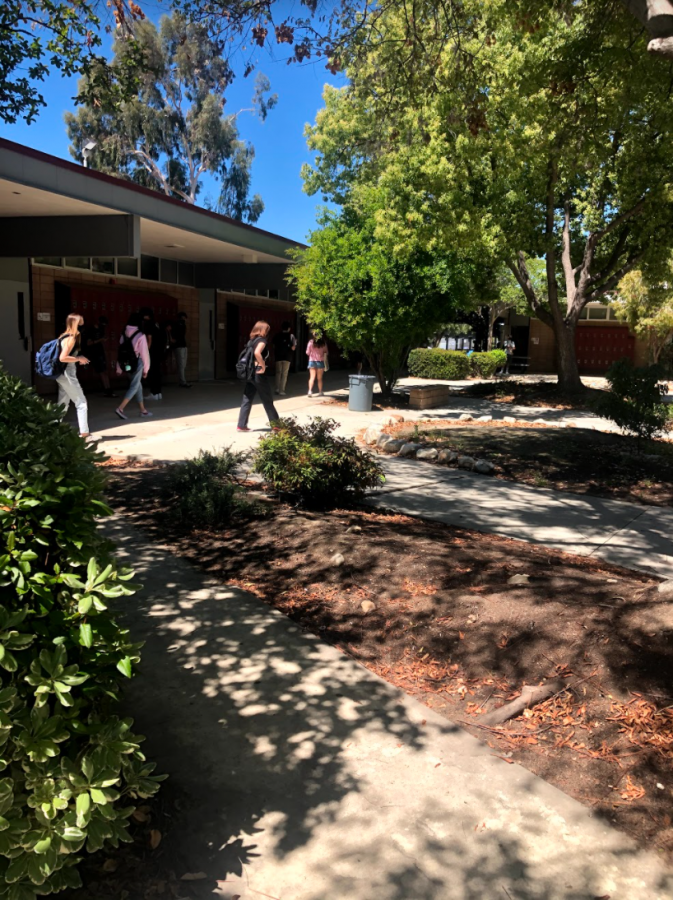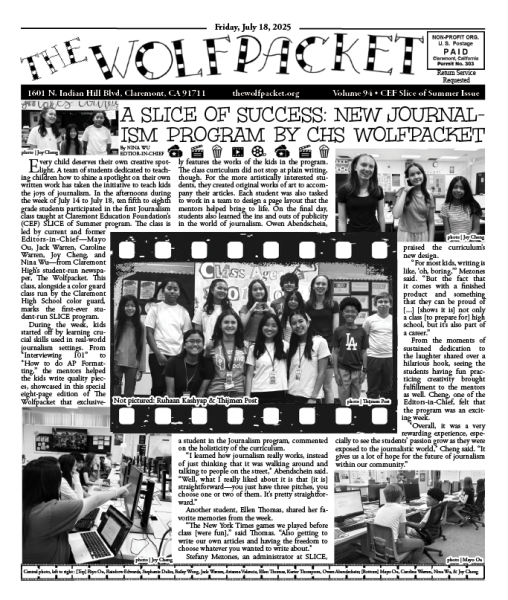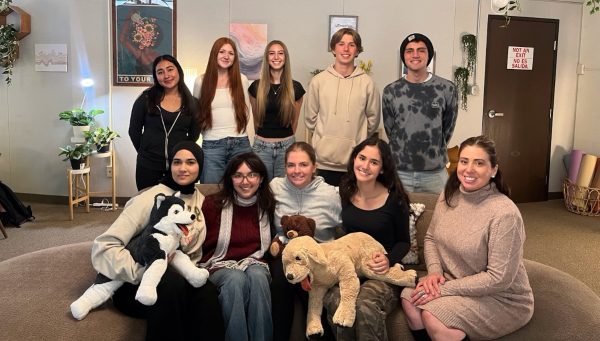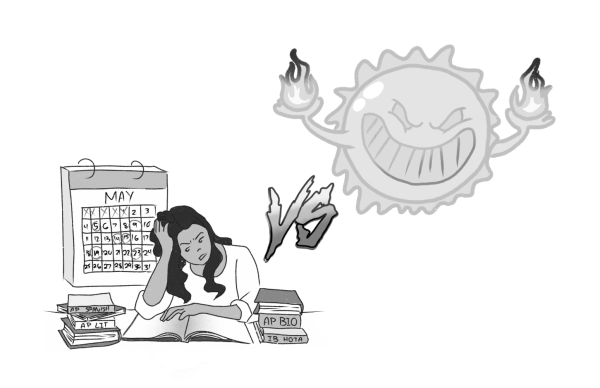From chatting to cheating: students and teachers navigate the return to the classroom
Students walk through the halls of the recently reopened Claremont High School.
All student quotes were submitted anonymously through questions posted on the Wolfpacket Instagram.
Almost a year to the day after CUSD originally planned to reopen campuses after their closure in March of 2020, some students have returned to CHS for in-person learning. On Monday, April 19th, more than seven months after the start of the 2020-2021 school year, CHS began the process of reopening their classrooms to students and staff. Complete with the construction of the Brett O’Connor Student Center, the hallways are again filled with students’ footsteps and laughter, and teachers are no longer only speaking to a computer screen. But school, as well as education in general, is not nearly the same as it was when students first left on that fateful Friday in March.
Even though CHS hallways are no longer silent, they are by no means full. With students split into two separate in-person learning cohorts, Cohorts A and B, and some students choosing to remain fully online in Cohorts C and D, teachers are having to balance providing for the needs of their students in the classroom as well as the ones at home. Ms. Tran, a CHS biology teacher, comments on the challenges of returning to CHS in the hybrid model.
“It’s always in the back of my mind — am I being fair to everybody, can I speak to everybody and make sure that everybody is heard?” Tran said.
CHS math teacher Mr. Casas has had a similar experience trying to balance fairness while teaching online and in-person.
“I tried not to change the way I taught a lesson, because I still have my online students, and they’re still my students and they still deserve the exact same lesson quality as in-person students do,” Casas said.
While teachers attempt to make students’ transition back to school as smooth as possible, the transition back to the CHS campus has still been a major change for students who have spent over a year adjusting to learning isolated at home.
“The desks are tiny and uncomfortable,” one CHS student said on the Wolfpacket Instagram.
But while time away from the classroom may have made students overestimate the size of the desks, it has also made them grateful for the social interaction they once took for granted.
“It has been fun so far,” one student said referring to the return to campus. “It’s good to see friends I haven’t seen in a long time!”
For other students, in-person school simply provides a way to consistently get out of the house. However, many CHS students have made the decision to stay completely online for the remainder of the school year. Mr. Casas explained that there is almost certainly no one overarching reason for students choosing to remain at home.
“Safety is obviously a big part of it,” Casas said. “But also, everyone’s living situation is so different, and their responsibilities and what they have to do at home. I think it was a personal decision based on a lot of different factors.”
No matter the reason students chose to stay home, the split between “Zoom” and “room” students, as some teachers have started to call it, has raised difficult questions regarding fairness and equity, in particular, when it comes to tests and assessments. There were questions as to whether it would be fair to use students’ one day of in-person class a week on a test, or whether it would be fair to force some students to adapt to taking the tests in a new environment while many of their classmates continued taking them at home. And finally, would it be fair if only some of the students were able to cheat?
For the entirety of distance learning, there was practically nothing teachers could do to prevent students from using outside resources such as the internet, notes, friends, or all three when completing examinations. Therefore, many students were concerned about the obvious inequity this would cause for students who returned to campus.
“If I take a math test in class I’ll be using Photomath and Desmos or walking out the door,” one student said.
While in a perfect world students’ internal morals would prevent cheating, the reality is that the pandemic, and only having two days of live online instruction, has made it significantly more difficult for some students to learn and grasp the material. Thus, many students have turned to cheating as a reliable option during distance learning.
“Yes,” one student said in response to a question about if they had cheated during online school. “It’s hard to grasp the material over zoom and don’t want to get a bad grade.”
“Why not,” another student said.
For many students, online school has made the question of whether to cheat feel like a “Why Not?” question. Why not, when the test perfectly matches a Quizlet set you found online? Why not, when you are still expected to take the same math quiz as students last year who received 5 days of in person instruction? And why not, when it is reasonable to assume everyone else is also cheating?
No matter their opinions on cheating, many CHS teachers have tried to modify their assessment methods to give all students as equal a chance as possible. Mr. Tran, for instance, has allowed students to bring a study guide to in person exams, while Mr. Casas has kept all his tests and quizzes completely online for students to complete at home.
From the morality of cheating to the importance of group work, online school has taught everyone about the necessity of access to an in-person education. However, it has also demonstrated that many of the things that are often taken for granted may not always be there. As the reopening process continues to present new challenges and the CHS hallways begin to fill with the laughter of more and more students, everyone can take inspiration from Mr. Casas’ positive attitude.
“I think what teaching online taught me is that there there will always be things that are out of my control, whether there is a pandemic or not,” Casas said. “I have the choice to complain about it and be defeated or I can choose to make it the best I can possibly make it.”
Hello there! Our goal is to provide relavent, engaging journalism for readers of all ages. Your donation will support the student journalists of the Wolfpacket at Claremont High School, and will allow us to purchase equipment, print our monthly issues, and enter in journalism competitions. We appreciate your consideration!

Meghan Mason is a senior at CHS, and this is her third year on the Wolfpacket staff. Mason is the Assistant Editor-in-Chief this year, and cannot believe...








